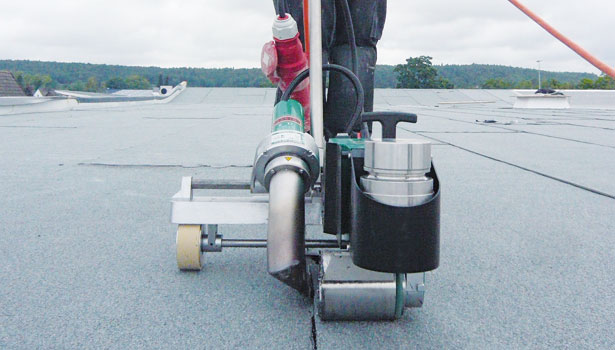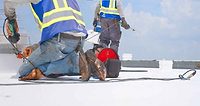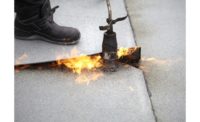Modified bitumen was developed in Europe in the 1960s and has been used as a roofing system in the United States since the mid 1970s. Combining asphalt with modifiers to give it either plastic (APP) or rubber (SBS) qualities, manufacturers sought to combine the durability and weathering capabilities of built-up roofing systems with the consistent manufactured quality and flexibility offered by single-ply.
Manufactured in rolls, modified bitumen can be applied in a variety of methods. Commonly, modified bitumen installers use adhesive-backed (self-adhered) sheets, cold process adhesives, hot asphalt, mechanical screws and plates, or torches to secure the modified bitumen to the substrate. It’s always good advice to check the manufacturer’s latest specifications on any installation. Proper application of the seams is critical. Some of the application methods require additional attention to the side laps and head laps after the sheets are installed.
Let’s talk specifically about the seam-welding aspect of a modified bitumen installation and what a change in technique can mean to you. There are two primary methods of seam welding this type of roofing system — open-flame torch or hot-air equipment. While both do a good job forming strong, watertight seals, there are distinct differences between them.
Open-Flame Torches
The open-flame seam welding process is pretty straightforward. Two sheets of modified bitumen are rolled out over a flat roof surface with their edges overlapping at least 4 inches. A torch operator then moves down the sheet heating the overlapped seam surfaces to the point that the material liquefies. The weight of the material itself secures the bond or a second operator follows, pressing the top sheet to the bottom sheet with a press wheel.
Operators use the open flame of a propane torch — which typically reaches temperatures between 2,192 and 3,000 degrees Fahrenheit — to melt the modified bitumen. These extreme temperatures can cause operators to accidentally overheat the material, which will damage its structural integrity and lead to weak, ineffective seam welds. In addition, there is greater risk of starting a fire on the roof’s surface or in the underlying roof structure. Lastly, the final result is highly dependent on the skill of the roofer and may have additional labor and material costs to dress the bleed out with loose granules.
In 2004, the Midwest Roofing Contractors Association (MRCA) established the Certified Roofing Torch Applicator (CERTA) Program, which is designed to teach contractors how to safely operate roofing torches. Since the introduction of this program, torch-related building damage has decreased significantly. Today many state building codes require that torch operators be CERTA certified, and many insurance companies won’t underwrite a roofing project that utilizes torches without a CERTA certified professional.
Hot-Air Welding
Typically hot-air welding is associated with thermoplastic roofing materials (i.e., PVC and TPO). Modified bitumen requires higher temperatures to effectively melt and fuse the material.
Fortunately, advancements in the power and heat potential of robotic hot-air welders have created a viable (and some would argue more effective) alternative to an open-flame torch.
Robotic hot-air welding machines apply heat to the modified bitumen seam through a flat nozzle that moves between the overlapped material sheets. The nozzle simultaneously concentrates the hot air directly on the sides of the sheets facing it, as well as the seam directly in front to preheat the area and allow the operator to move at a faster pace.
Directly following the nozzle is a pressure roller, which focuses the machine’s weight directly over the seam, firmly pressing the sheets together. These machines automate the seam welding process so much so that the only requirement of the operator is to ensure the machine’s heat and speed are properly configured for the material and environmental conditions, and that the machine doesn’t veer off-course during the weld.
For roof-edge or confined-area welding, hot-air hand tools can generate the required heat to bond modified bitumen seams, and a standard hand-held pressure roller can apply the necessary pressure.
Hot-air welding tools reduce the threat of fire by eliminating the use of an open flame. Most hot-air welders only require one operator, freeing others to work on different aspects of the roofing project. In addition, because these hot-air welders automate the delivery of consistent heat and pressure, the threat of human error is reduced, limiting the amount of touch-up work required and resulting in consistent, repeatable welds.
Of course, it is important to note that not all safety risks are eliminated with hot-air welders, as these machines still produce high concentrations of heat, which if left unattended or near flammable material or objects can cause
a fire.
In addition, if a nozzle slides out from between the seam during a weld, it has the potential to spray melted bitumen in the direction of the operator. For this reason, manufacturers typically recommend wearing protective clothing, gloves and goggles.
In roofing, profitability and growth are contingent on completing roofing projects in a timely and efficient manner, and delivering consistent, quality work. Making the switch from open-flame torches to hot-air equipment to install modified bitumen is one small step you can take today to help in these pursuits.



Report Abusive Comment